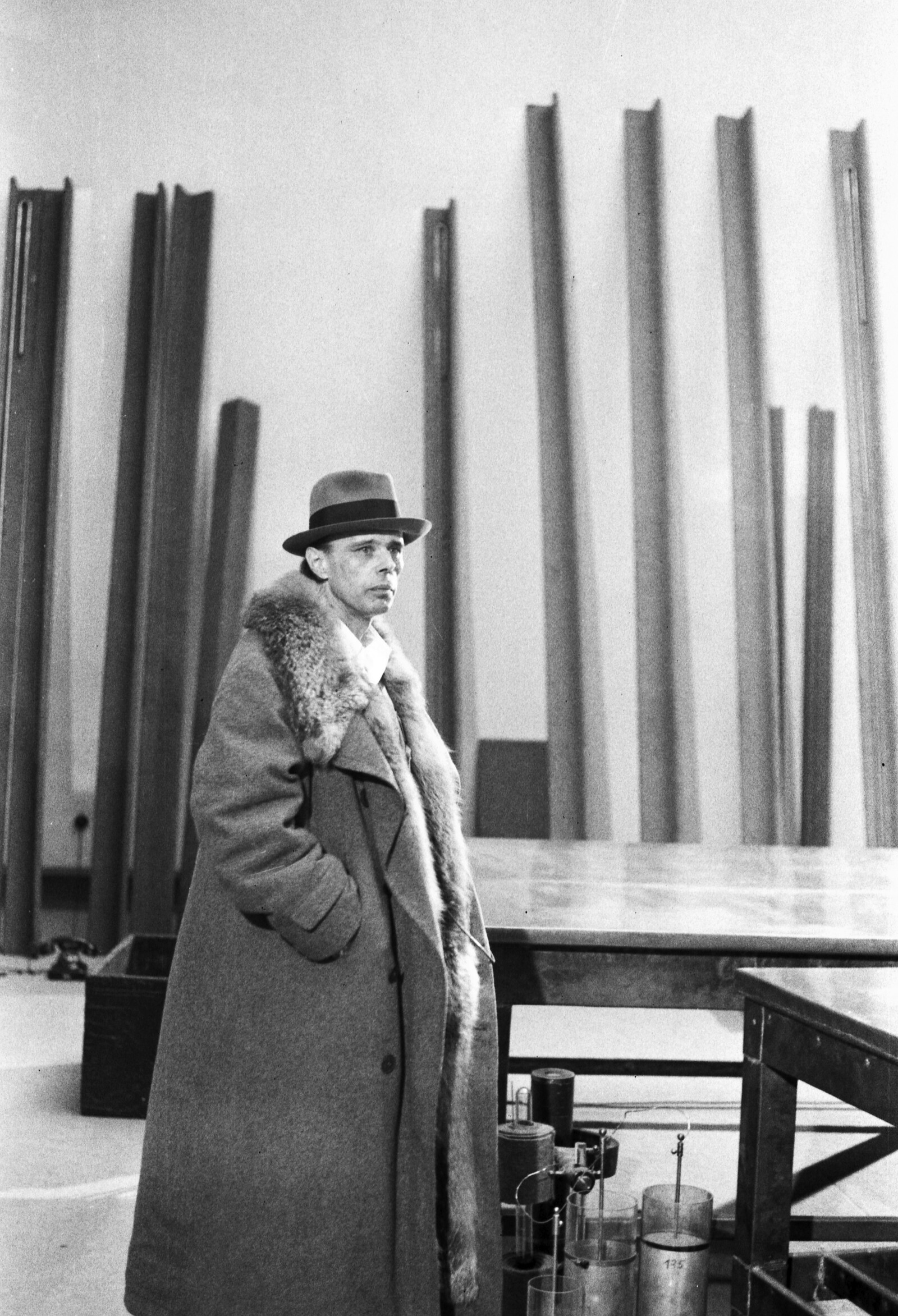Kraftwerk Block Beuys
February 14–May 24, 2020
Friedenspl. 1
64283 Darmstadt
Germany
In April 1970, Joseph Beuys (1921-1986) installed his Block Beuys in the Hessisches Landesmuseum Darmstadt. To mark the 50th anniversary of this occasion, the exhibition documents the production of and alterations to this largest extent work complex in the world. Films, photographs and scores show how Beuys made previous use of objects from Block Beuys.
Block Beuys now consists of 290 works made between 1949 and 1972. They include expansive installations like Transsiberian Rail, FOND II and FOND III, iconic works such as the famous first Fat Chair, the vitrine Auschwitz Demonstration, Mountain King and Felt TV as well as drawings and watercolours on paper.
The seven rooms in which Block Beuys is exhibited makes up a fascinating artist’s museum within the museum. In this unique school of perception and wonder, it becomes evident that Beuys comprehended mysteriousness as an invitation to further intuitive thinking. He arranged his works without labels. Experiencing was more important for him than explaining.
As a visionary, Beuys is more topical than ever. Universal in his aspirations, he connects art, science and spirituality. He above all seeks in his performances to “make art so large that it can encompass every human activity.” In doing so, he not only still puts our notion of art to the test today but also our idea of the museum.
Beuys called his works vehicles that transported his ideas. The Darmstadt Block Beuys is a storage facility in the sense of energy storage. In conjunction with the battery idea, Beuys stacked felt and copper as a reservoir of spiritual warmth and creativity. The works in the Block Beuys have titles like Transmitter, Electrode, Battery, Aggregate or Fond. Even the title Block Beuys itself can be understood as a power plant.
The exhibition sheds light on the context of selected works from Block Beuys and exemplary actions. In 1963, Beuys, then a professor at the Kunstakademie Düsseldorf, organised a FESTUM FLUXORUM FLUXUS. In 1964, a photograph showing Beuys with a bloody nose after a tumult at the “Festival of New Art” in Aachen was disseminated by the press. In 1965, he demonstrated at the Galerie Schmela in Düsseldort How to Explain Pictures to a Dead Hare. These were followed by Homogenous Infiltration for Grand Piano, The Greatest Contemporary Composer is the Contergan Child, Felt TV and MANRESA. The exhibition then introduces Primary Current FLUXUS, EURASIA STAFF from 1967 and finally Titus Andronicus / Iphigenia from 1969.
Block Beuys is simultaneously a prime example for the birth of the Western German art market of international significance. Through the intervention of Franz Dahlem and Heiner Friedrich, the Darmstadt industrial Karl Ströher acquired all the works from Joseph Beuys’s 1967 exhibition at the new Museum Mönchengladbach. He secured an access to the further production and committed himself to publically exhibiting all of these works as a whole. In 1968, Ströher acquired the extensive Pop Art collection of the New York insurance broker Leon Kraushar. Following a two-year exhibition tour, Ströher presented his collection as a long-term loan, making Darmstadt a venue of the avant-garde.
Curator: Gabriele Mackert, HLMD
Symposium (in German)
The Museum as Permanent Conference
March 28 and 29, 2020
Registration is open from February 1, 2020 at www.hlmd.de
Especially during the nineteen sixties, a time when numerous institutions were being radically questioned, Joseph Beuys wanted to present his art in museums. He did not view them as superfluous but as potential. They seemed to be expanded universities for him and he developed large display cases for objects and other documents from his actions with the intention of putting the works up for discussion on a permanent basis. The symposium discusses Beuys’s display strategies, his scientific and folk cultural references as well as the mediatization of action art.
Speakers
René Block, curator, publisher, Berlin; Nicole Fritz, Kunsthalle Tübingen; Melitta Kliege, FAU Erlangen-Nürnberg; Magdalena Holzhey, Kunstmuseen Krefeld, Antje von Graevenitz, University of Cologne, Gabriele Mackert, HLMD Darmstadt, Matthias Weiß, FU Berlin; Fiona McGovern, University of Hildesheim
March 28, 2020, 7pm
Presentation “Berlin: Neues vom Kojoten”
with René Block, curator and publisher, Berlin
May 9, 2020, 7pm
Panel Discussion Art and Politics (in German)
“Creativity is the only revolutionary force”
Art and politics have always been closely linked. The question whether art can be political is just as old. It should serve nobody and not fulfil any purposes but evolve in accordance with its own rules. It is nevertheless pressured in turn by activists as well as populists. Art is in addition an international market system with integrated record auction results. Can it be a place of change under these conditions? In what sense can art be political or made political today?
On the panel: Alice Creischer, artist; Alexander Koch, director New Patrons, Berlin; Wolfgang Ullrich, art historian and author; Philipp Ruch, Center of Political Beauty; Moderator: Elke Buhr, editor-in-chief Monopol
Supported by: Hessische Kulturstiftung, Freunde des Landesmuseums Darmstadt e. V., MONOPOL – Magazin für Kunst und Leben, ALNATURA
Press contact: Yvonne Mielatz-Pohl, yvonne.mielatz-pohl [at] hlmd.de / T +49 (6151) 1657 100


